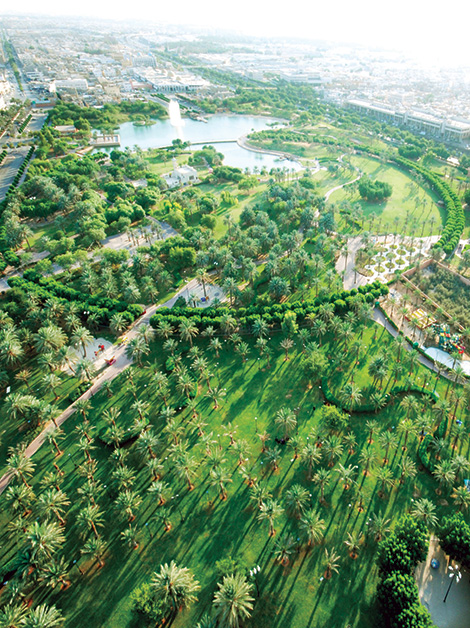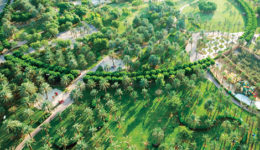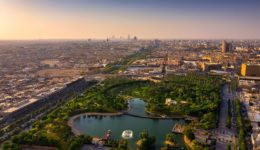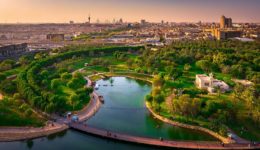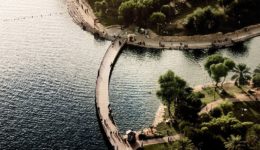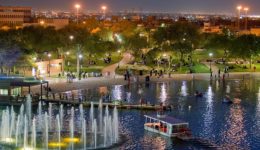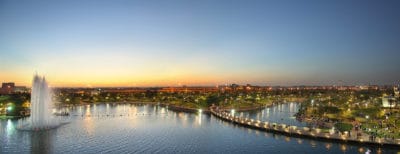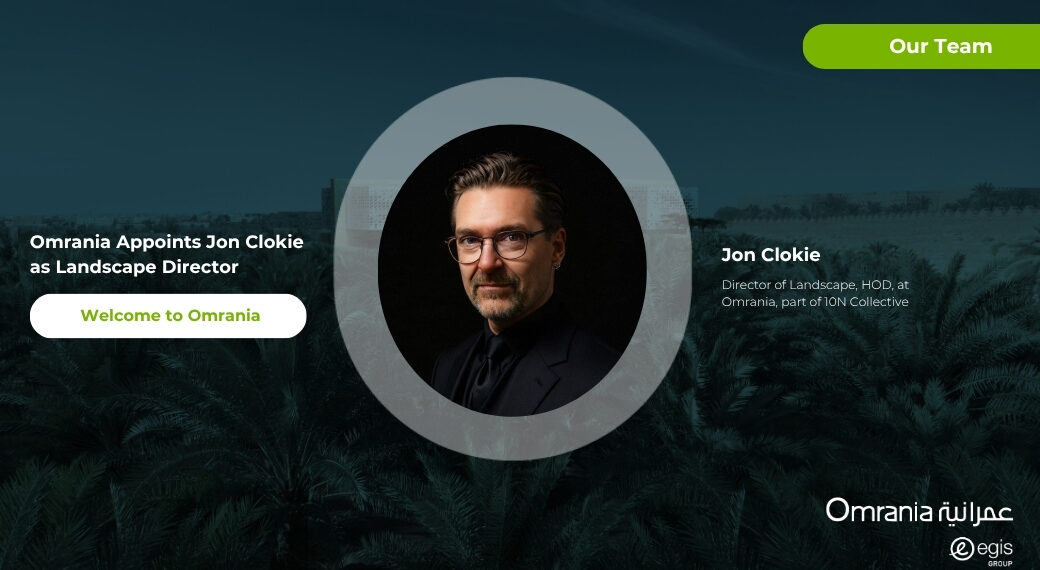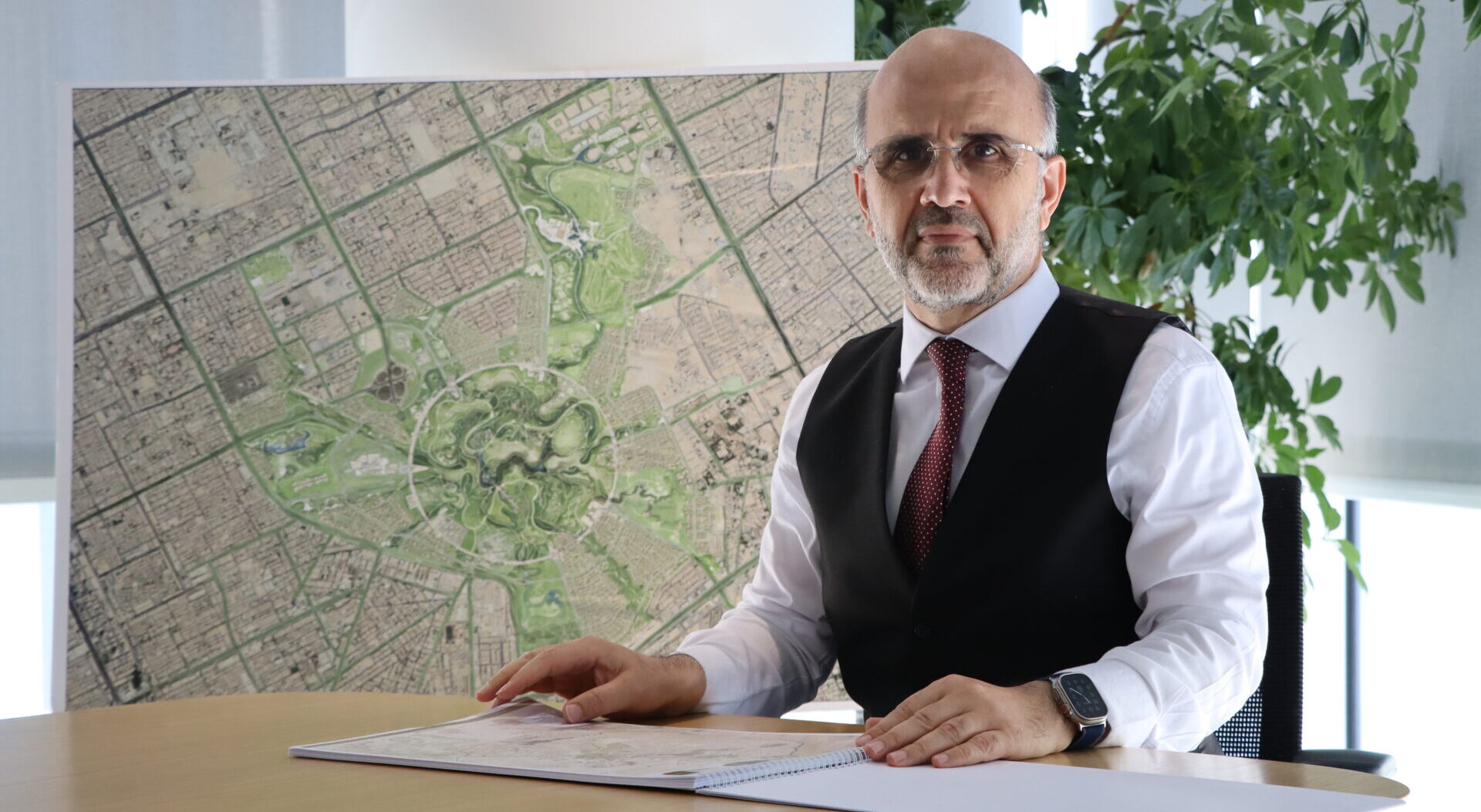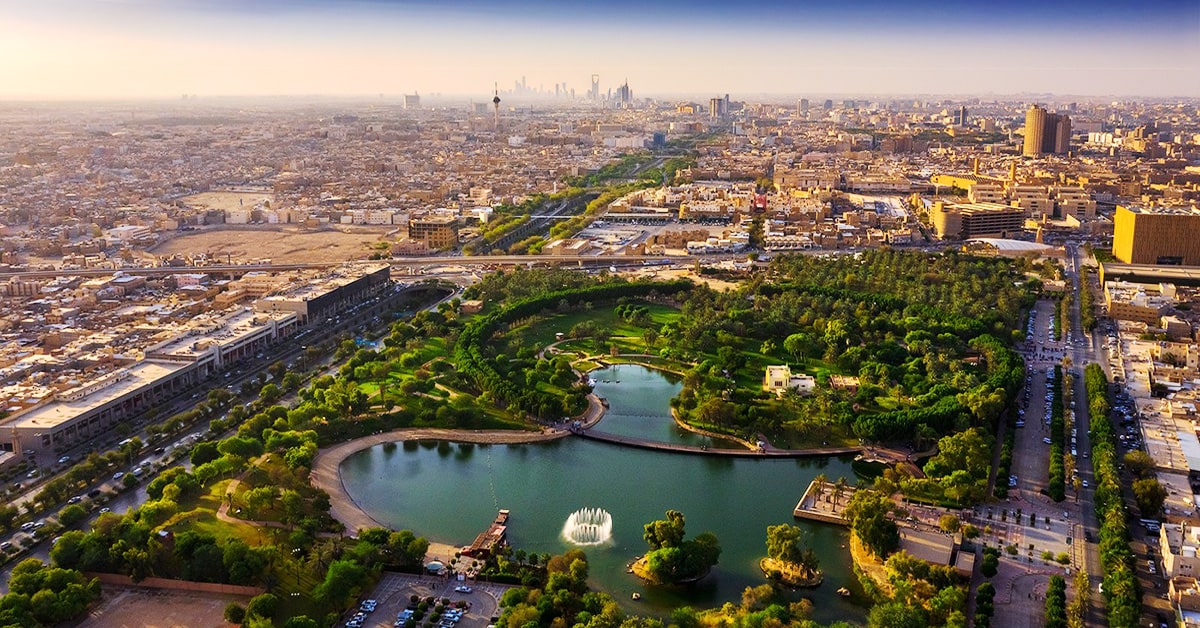 Salam Park, Riyadh, Saudi Arabia. Photo © Ali Alsuhaibani
Salam Park, Riyadh, Saudi Arabia. Photo © Ali Alsuhaibani .
In the third part of our four-part series, we explore the critical issue of water scarcity and how the built environment has contributed and might contribute less to the diminishing of our most precious naturally occurring commodity; not oil or gold, but water.
By: Marcus Leyland – Chief Architect
As an arid desert country, Saudi Arabia has always recognized that water is their most precious community, perhaps more than Oil, Gold, or any other commodity within the Kingdom. Without water, life itself would be impossible. Only recently, however, has water scarcity become a commonly recognized issue amongst a majority of the population. For the first time, the possibility that there may not be enough water economically available for the countries rapidly growing population has become a widely understood fact in the minds of decision-makers and an increasing majority of the population.
Current projections indicate that per capita availability of aquifer derived water is likely to be half its present amount by 2050. Some climate change scientists predict that average rainfall across the Kingdom may fall by as much as 20-30% by 2017, further depleting aquifers. The long-term solution lies in increased desalination of seawater of non-potable uses, with power generated by solar energy so as not to further diminish precious oil reserves necessary for export. Potable water manufacture will also need to grow, again, utilizing solar-generated power.
Whilst many people are concerned at the prospect of being without or having a limit to available water resources for drinking, bathing, and other uses, there is no consensus yet on how to manage the issue. In this article, we explore how the way in which buildings may contribute to the problem and how they might offer solutions towards a more sustainably managed future for water use in the Country.
It is currently estimated that residential buildings consume nearly 10% of water used within the Kingdom annually. In the UAE, a staggering 20-22% of this is currently from energy-intensive desalination processes, for the most part, generated by burning the countries oil reserves. A further 00% is consumed by industry and commerce, and 00% through other non-building related uses. In perspective, these figures equate to an average daily water consumption rate per person of between 260 and 320 liters. This compares with 575 liters per person in the US, 320 for Spain and 155 for the UK. As most economically accessible aquifers are largely at or near capacity, manufacturing the water would be the only option available. A recent study, based on projected population growth over the next 14 years to 2032, showed that this would require 25GW of power to create the necessary desalinated water needed to meet demand. Reverse osmosis powered using solar PV is seen as a preferable means of generating this power over concentrated solar or oil, with the first significant test of this technology at SWCC’s plant in Al Kharj.
The country faces three choices: Firstly, to divert increasingly costly to extract oil reserves into water production to maintain present rates of usage. Secondly, to switch to an alternative type of energy to meet current and future demand, and thirdly, to reduce usage by conservation measures like those used in most other developed countries. The growing consensus amongst decision makers is that a balance between a switch to alternative power for water production, and a range of conservation measures, offers the right approach for the long-term. Inevitably, the currently heavily subsidized cost of water supply and wastewater management to the consumer will have to rise significantly as new infrastructure is built, and existing system wears out and need replacement. Besides, the real cost of the energy required to convert seawater to a resource usable in the home is likely to become more reflected in the price of water to the consumer.
As buildings and the built environment are a significant source of water use, they also offer a platform from which a sustainable water management plan can be delivered. We will explore here five aspects and some innovative solutions for each that will result in a more efficient use of this most precious commodity.
Landscape Design
Historically, Green Space has been valued for its agricultural contribution to society and culture. In central, Eastern, and southern Provinces, green space was scarce and limited to the jealously guarded oases set amongst otherwise barren rock and sand desert. In Eastern Province and areas of the north, terrain results in a more semi-arid climate where water is a little more plentiful, and then only during a few months of the year. Only in the mid-to-late twentieth century did the notion of the ornamental and recreational role of green space become appreciated and valued by much of the population of the Kingdoms main cities. Landmark projects such as Salam Park, the lush parkland setting of DQ, the restoration of Wadi Hanyfah and the more recent, and still to be complete, King Abdullah International Gardens demonstrate the possibilities of plentiful water supply in landscape design.
And yet water conservation was foremost in the minds of the designers even before water scarcity became a commonly recognized issue. The Salam Park project incorporated state of the art technologies for water treatment and monitoring to minimize loss. The most prominent feature of the park is its lake and 30m high water jet fountain. The cascading water from the fountain provides aeration of the waters for propagating its fish stocks and aquatic life.
Functionally, the 4.5m deep lake acts as a central irrigation reservoir serving the many thousands of plants, trees, and shrubs within the park. Water feeding the lake originates in treated grey water which is processed at the nearby reverse osmosis plant. Water is also taken from groundwater as a means of alleviating hydrostatic pressure from an occasionally high-water table on adjacent tunnels and other below-ground structures on the King Fahad Road.
Many measures were taken to ensure constant and adequate water movement to prevent the establishment and propagation of mosquitos and their larvae. This included measures to eradicate bryophyte mosses which could harbor larvae. These measures included the reverse osmosis plant, sand filtration, U.V. transponders, fountains, and extensive pump systems to ensure water movement. Also, plants and fish known to be hostile to or predators of mosquito larvae were stocked.
Salam Park, Riyadh, Saudi Arabia
Modern landscape design that addresses water scarcity places water management as a primary consideration in design. This is centered on a ‘whole life’ concept of water management that considers water capture or source, adaptation for use, efficiency of use, minimization of loss, recovery, and storage ready for reuse. Plants and landscape forms are shaped and selected by the best means of mitigating water loss be it through evaporation or permeation through the ground.
Water flow and quality monitoring technologies employed in contemporary landscape design allow both owners and Landscape Architects to understand better the effectiveness of their designs, and to improve, adapt to replace elements that underperform or fail.
Street and Urban Space Design
As part of a modern integrated infrastructure system, water supply and drainage are typically incorporated into a highly coordinated network of services systems that accounts for initial and future distribution demands. The major challenge facing water is the longevity and durability of this system, and its capacity to respond to often dramatic changes in demand as cities expand both laterally and vertically.
Many new cities developed in the Middle East during the 1970’s and 1980’s failed to pre-plan infrastructure well. This included how potable or mains water would be supplied, and wastewater removed. This resulted in massive and costly overprovision being required that during times of wealth was not seen as an issue. Discharge of wastewater was often haphazard with no regard for treatment or recycling, nor its impact on the ecosystem into which it drained. These older systems were not maintained well, and today Saudi Arabia loses around 30-35% of distributed potable water through leakage; primarily within the primary distribution infrastructure.
Today, cities and towns use around 9% of total annual available water within Saudi Arabia. Those designing both new planned settlements and major developments within existing Cities in the new Millennium recognized the shortfalls in this earlier period of design, and the long-term consequences both environmentally and economically. Today, an array of technologies is available to urban planners and engineers to alleviate the economic, environmental, and aesthetic impact of wasteful design and poor management of grey (partially reusable) and black (non-recyclable) water after use.
Beyond the present, the UNESCO 2030 plan sets out an agenda for radical change in the socio-economic role of cities in the future. Formulated at the 2016 Habitat III Conference in Quito and published in 2017, the plan includes a radical series of transformative measures aimed at making cities the primary tool for alleviating the challenges that increasing overpopulation of the planet is beginning to manifest in the early 21st century. The logic behind the report and measures proposed are by no means universally accepted amongst the major nations of the world and remain politically controversial within and amongst those who currently provide the majority funding for the UN.
Office and Schools Design
Water use in Offices and schools includes both that used for sanitary purposes, and for heating and cooling. Many people spend more of their waking hours in offices than in their homes, and whilst not washing, showering, and cooking, the average daily use of water per person, typically exceeds that for a residential building type.
Water use efficiency for washrooms is today commonplace with the use of low flow and dual flush fixtures standard in well designed, modern office buildings. Less common is the treatment, storage, and reuse of ‘greywater’ for flushing purposes, and for irrigation of landscaped areas. This relatively new technology requires an initial investment but offers significant long-term savings in potable water usage.
Water use in air conditioning and cooling systems account for as much as 25% of total water use within the building. The most efficient HVAC system in use today is ‘closed’ systems where if operated correctly, almost all water usage is through evaporation, bleed off and drift wastage through the cooling towers. Return on investment for improvements to cooling tower performance and efficiency can return significant sums over relatively short durations, with the return on investment being higher for more water intensive buildings such as hospitals and schools.
Perhaps the most significant indirect way in which water efficiency can be improved in an office or school is in the way that facades and roofs are designed to reduce heat transfer to the interior. Façade systems that reject or reflect heat are desirable, reducing the load demanded on HVAC systems in the first place. Roofs may be provided with shading structures such as solar panel arrays or if an occupied, space, the use of horizontal Mashrabiahs or green screes such as rooftop plantings can act to reduce direct sunlight on roof surfaces. These surfaces can be designed with high reflectance finishes that again minimize solar energy transmittance into the interior. Such highly reflective or shaded roof surfaces have the added benefit of reducing ‘thermal cycling’ within the roof assembly, increasing the service life of that system.
Offices and schools also offer an opportunity for authorities and businesses to provide education to workers and students about the importance of water conservation, and the way in which making savings now might reduce the cost of expanded infrastructure for today’s workers and students, and those the future.
Residential Design
Residential buildings account for the majority of building-related water use. Today, average per capita use of water in the Kingdom is 260 liters per day, although in Riyadh the figure is closer to 320 liters per day, with this figure rising steadily at the rate of 4% per year. Water use in the home is through four principle sources of use. Primary uses such as washing and cooking, secondary uses such as toilet flushing and cleaning, and tertiary uses such as external landscape irrigation, car washing, and swimming pools. A fourth aspect that should also be considered is wastage both within residential streets and within homes, a major contributory factor in water consumption within the country.
Historically source water has either been mains supplied, and bought in potable water, like most mains water including that from desalinated sources is not suitable for human consumption. In recent decades, and with increasing wealth within Saudi society, bottled drinking water has become the standard means of providing safe drinking water. The impact on both the economy in terms of this costly means of providing drinking water to the population, and the impact of tens of millions of plastic bottles becoming waste is only now being recognized as an unsustainable situation. Wastewater typically was removed through a single combined sewer with all waste water treated as disposable.
Contemporary approaches to water management are based on a more sophisticated model of both supplied water and wastewater, with water use limiting technologies and treatment and reuse where possible. Metering of both supplied and wastewater allows the customer to gain a better understanding of how their water use is impacted by the addition of new smart water management technologies within the home.
These technologies include smart meters that continuously monitor water use according to the time of day that it is drawn from the main. To reduce peaks in use that may overburden the distribution network, higher charges at these peak times act to dissuade consumers from non-essential water use at these times. For example, car washing, irrigation and the use of washing machines can be carried out outside of peak morning and early evening timeframes. Many of these meters monitor water flow rates so precisely that they can determine when a leak on the system is present and notify the householder on their smartphone of the problem. They will even detect sudden pipe bursts and shut off the water supply to avoid a flood in the home.
Solar powered, domestic scale grey water capture and reuse systems can store water from washbasins and sinks in a treated form, for use in toilet flushing and irrigation. Whilst there is an initial cost to such a system, it can significantly reduce the amount o water entering the wastewater drainage system, reducing associated charges to the consumer over the long term.
Simple and established technologies such as flow rate restrictors applied to taps and showers, and sensor activated, timed faucets and shower heads can reduce significantly mains water needed for most washing fixtures. Dual flush cisterns equally can save on water use for toilets.
As the cost of water to the residential consumer inevitably rises to build new, and maintain existing infrastructure, this metering technology is perhaps the most significant means of reducing water waste as it brings a new awareness to the consumer of the real economic cost of their use if the resource. Those who invest now in these smart systems will be least impacted once country-wide Water Demand Management policies and practices, including the significant consumer price increases for municipal water and drainage services required to cover the cost of infrastructure renewal and expansion.
Agriculture
Within Saudi Arabia, agriculture accounts for around 85% of the total annual usage of available water. This figure compares with comparable statistics of 80% for Canada, 70% globally, 44% for Europe (65% for Southern European Countries). While recognizing that for Saudi Arabia, significant economies and reductions in water use in agriculture such as the use of drip irrigation systems, must be at the heart of any strategic Water Demand Management, this article focus is focussed on the built environment. We shall also explore some innovative ideas as to how agriculture can be better integrated into the city; realizing savings in water use and energy consumption as a result.
In the arid and semi-arid southern and central US, rooftop farms are rapidly becoming a popular way to bring agriculture into the city. Farms range in size from 75,000 square feet or 2 acres, to as small as 800 square feet have proved successful examples of bringing agriculture closer to the end user. The world’s largest example at 2 acres is Gotham Greens rooftop greenhouses outside of Chicago. This site is just one of their facilities comprising more than 170,000 square feet of rooftop farms in two cities. The largest of these is situated above a manufacturing facility in South Chicago, the site employs 50 full-time workers and produces more than 10 million crops per year. Fresh produce is sold in reputable, select local and national retailers, as well as through food cooperatives within the city. Whilst not significant in terms of carbon emissions, the distance and time saved in not having to pack and transport produce means that significantly less produce is lost in transit due to rotting and insect damage. All the power needed for lighting, ventilation and water supply is generated on the site utilizing solar power and battery storage.
In addition to providing an efficient location for the growth of produce, the soil on the roof of the building acts as a means of protecting the roof assembly against the effects of the weather, including the degrading effect of the sun on the roof membrane. Creating a 12” deep thermally stable layer, this significantly increases the service life of the roof, saving on repair and maintenance costs in the long term.
The global potential for urban and particularly rooftop farming is estimated to be in the order of 10% of global production. As water efficiency is maximized by this method, with distribution and groundwater loss minimized, and using a computer-controlled drip irrigation system, the solution offers a highly economically efficient solution for dry and arid countries.
Vertical farms or Controlled Environment Agriculture is a further development of urban farms, where the growth plane is rotated 90 degrees towards the sky. This technology requires an alternative form of growth medium and irrigation to be efficient. There are currently three approaches to CEA, hydroponics, aquaponics, and aeroponics. Each offers a different growth medium concept and a tightly regulated water supply. This technology is still in embryonic form but may in the future, in the world’s largest and most dense cities, offer an economically viable solution in years to come.
Conclusion
What is certain is that demand for water is approaching the point where it will exceed that which is economically feasible to extract or convert: What is uncertain is the point at which this becomes a crisis. A combination of policy and technological practice, using tried and tested solution offers a new approach to balancing supply and demand with the third approach of conservation. Buildings play a significant part in this new future, with Architects and Engineers having to reconsider how water is managed within their creations.
Omrania, a renowned architecture firm, has established a reputation for excellence in blending aesthetic and functional design, setting a benchmark for architecture firms in Riyadh, Saudi Arabia.






